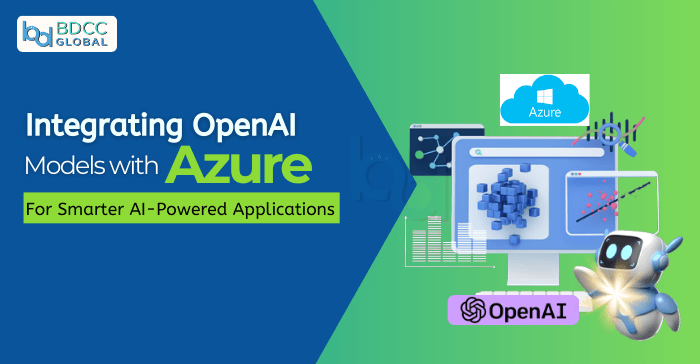
Artificial Intelligence (AI) has moved from a futuristic buzzword to a foundational technology shaping modern software. From automating customer support to enhancing business intelligence, AI is now a key enabler of digital transformation. Among the most powerful AI offerings today are OpenAI’s models—like GPT-4, Codex, and DALL·E—widely adopted across industries.
But harnessing these models effectively requires more than just API access. It demands an environment that’s secure, scalable, and enterprise-ready. That’s where Microsoft Azure comes in. With its native support for OpenAI, Azure enables developers and enterprises to integrate AI directly into applications, workflows, and business logic with ease.
In this blog, we’ll explore how to seamlessly integrate OpenAI models on Azure, the real-world benefits, step-by-step guidance, and expert insights to help you build smarter, more adaptive applications.
Why Azure Is the Right Place for OpenAI Models
Before diving into the technical how-to, it’s important to understand why deploying OpenAI on Azure is the preferred route for many organizations.
Microsoft’s deep collaboration with OpenAI means that Azure is not simply a hosting platform—it’s a tailored ecosystem built around OpenAI’s capabilities. When you use OpenAI models on Azure, you gain:
- Enterprise-grade security and compliance: Azure meets major regulatory requirements like GDPR, HIPAA, ISO, and SOC 2.
- Global scalability: Easily deploy across multiple regions to reduce latency and serve a global user base.
- Integrated ecosystem: Seamlessly connect with Azure services such as Azure Functions, Logic Apps, Azure ML, and Cognitive Services.
- Developer flexibility: Use familiar languages (Python, C#, JavaScript) and frameworks via REST APIs and SDKs.
- Usage monitoring and governance: Set quotas, review logs, and manage access using Azure Monitor and Azure Policy.
These features make Azure the ideal launchpad for AI-powered solutions that need reliability, transparency, and governance at scale. It is even capable of AI-Driven threat detection system.
Step 1: Getting Started with Azure OpenAI Service
To begin your journey with Azure AI integration, the first step is to gain access to the Azure OpenAI Service. This isn’t a public offering by default, so you need to apply for access.
- Visit the Azure OpenAI documentation
- Sign in to your Microsoft Azure account
- Complete the access form outlining your intended use cases
- Once approved, you’ll be able to create and manage OpenAI resources via the Azure Portal
Azure then provides a fully managed endpoint, along with keys and region-specific configurations. This setup ensures your applications remain secure and consistent.
Step 2: Deploying Your OpenAI Model on Azure
Once you have access, creating an OpenAI resource is as simple as provisioning any other Azure service.
- Navigate to your Azure dashboard.
- Search for “Azure OpenAI” and click “Create”.
- Select your subscription, region, and pricing tier.
- Choose the model you wish to deploy—gpt-35-turbo, gpt-4, text-davinci-003, etc.
- Complete the setup and obtain your API endpoint and key.
With this, your Azure environment is ready to accept requests via REST API or SDK integrations.
Step 3: Using the OpenAI API with Azure in Your Application
After deployment, you can call the model via Azure’s API endpoints. This is where developers can bring AI into any app—web, mobile, desktop, or serverless backend.
Here’s a simple example in Python to illustrate how you can send a prompt and receive a response from a GPT model hosted on Azure:
import openai
openai.api_type = "azure" openai.api_base = "https://<your-resource-name>.openai.azure.com/" openai.api_version = "2023-03-15-preview" openai.api_key = "<your-api-key>" response = openai.ChatCompletion.create( engine="gpt-4", messages=[ {"role": "user", "content": "Explain how to integrate OpenAI with Azure."} ] ) print(response["choices"][0]["message"]["content"])
This integration can power intelligent search, conversational interfaces, dynamic content generation, or even automated reasoning—depending on your use case.
Real-World Applications of Azure + OpenAI Integration
Let’s look at what happens when businesses deploy OpenAI on Azure in real-world scenarios.
Across industries, companies are using AI to automate tasks, improve user experience, and increase operational efficiency. Here are some of the most common use cases:
- Customer Support Automation
Build intelligent chatbots that handle everything from FAQs to refund requests—24/7—using GPT-powered conversation flows.
- Smart Document Processing
Summarize legal documents, extract key insights, or auto-generate reports using text-davinci-003 or GPT-4.
- Software Development Tools
Use Codex for AI pair programming, error handling suggestions, or documentation generation inside IDEs.
- Healthcare and Diagnostics
Convert symptom descriptions into structured clinical notes or interpret patient data using natural language prompts.
- Content Creation at Scale
Generate blogs, product descriptions, or personalized marketing messages—all from one AI-powered content engine.
These applications demonstrate the depth and versatility of building AI-powered applications with Azure that are more responsive, accurate, and scalable.
Managing Security, Cost, and Governance
As with any cloud-based system, operationalizing AI requires careful attention to infrastructure hygiene. Fortunately, Azure provides built-in tools for governance and safety.
Here’s how to ensure responsible use of OpenAI models:
- Secure your credentials using Azure Key Vault to avoid hardcoding sensitive keys.
- Authenticate via Azure Active Directory (AAD) to assign role-based access and track usage across teams.
- Monitor and control costs by tracking token consumption through Azure Monitor and setting quotas.
- Enable content moderation to filter out inappropriate responses, especially for public-facing AI systems.
- Use Private Endpoints to isolate your API traffic from the public internet for additional protection.
These practices aren’t just best practices—they’re essential when deploying enterprise-grade AI.
Best Practices for Long-Term Scalability
Deploying your first AI-powered feature is exciting. But to scale confidently, consider these key tactics:
- Prompt Engineering
Refine prompts iteratively. Specific, structured inputs lead to more predictable and relevant outputs.
- A/B Testing and Feedback Loops
Test different models or prompt variations to see which performs best. Use user feedback to improve accuracy over time.
- Multi-model Architecture
Consider combining GPT with other Azure AI tools—like Form Recognizer or Cognitive Search—for rich multimodal workflows.
- Version Control and Deployment Pipelines
Treat your prompts, model versions, and AI workflows like production code—track changes, test in staging, and roll out via CI/CD.
By embedding these practices into your development lifecycle, you’ll be better equipped to maintain, monitor, and optimize your AI-driven features over time.
Common Pitfalls to Watch Out For
While Azure simplifies integration, there are still some common traps to avoid:
- Overusing tokens: Remember, longer prompts and responses cost more. Optimize token use to balance quality and cost.
- Ignoring latency: AI responses are fast—but not instant. For real-time apps, optimize caching and minimize request sizes.
- Underestimating user input variance: Real-world users ask unexpected questions. Test your prompts against edge cases.
- Skipping moderation: Always implement a content filter, especially in customer-facing systems.
Avoiding these mistakes ensures smoother deployment and a better experience for both users and developers.
Final Thoughts: From Exploration to Enterprise
Integrating OpenAI models on Azure is more than a technical decision—it’s a strategic move toward future-ready applications. Azure offers the tools, flexibility, and security businesses need to turn AI from an idea into a competitive advantage.
Whether you’re building a virtual assistant, a smart document processor, or a predictive analytics engine, Azure AI integration gives you the confidence to scale with control and clarity.
If you’re ready to build AI-powered applications with Azure, now is the perfect time to start experimenting. The platform is mature, the tools are accessible, and the possibilities are endless.
BDCC
Latest posts by BDCC (see all)
- Cloud computing in healthcare: Uses and benefits - June 23, 2025
- What are the Best Practices for Terraform File Structure? - June 10, 2025
- From Monolith to Microservices: DevOps Strategies For a Smooth Transition - June 5, 2025

